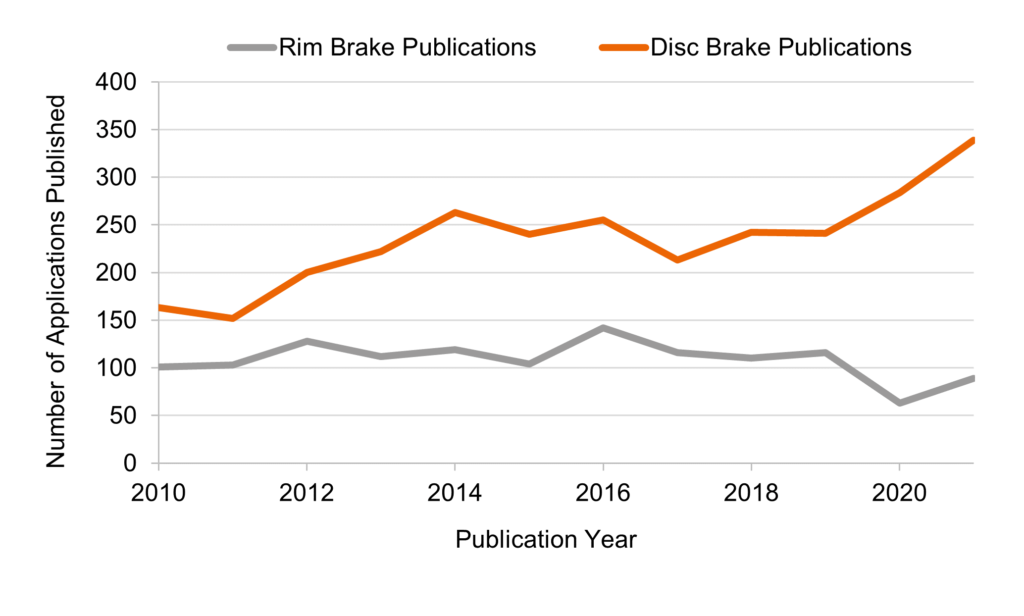30/06/2022
With the 2022 edition of the Tour de France kicking off on the 1st of July, those tuning in may notice a distinct difference in the bicycles used compared to those used only three or four years ago: the humble rim brake, a calliper with rubberised pads used to grip a rotating wheel rim, has now made way for disc brakes.
Disc brakes, as the name suggests, instead rely on a calliper’s brake pads gripping a metal disc affixed to the central wheel hub – similar to the system used in most modern cars. Their usage in the world of cycling extends back much further in disciplines such as mountain biking, but their introduction to road cycling is particularly recent. Manufacturers claim that disc brakes offer better braking performance, particularly in the wet or on long alpine descents, and better braking modulation. The shift towards their use has come at such a pace that the latest road bikes offered by many manufacturers have done away with a rim brake model altogether.
It seems as though 2022 may be the first year without any rim brake bikes in the peloton at the Tour de France. Since their inception in 2009, the Ineos Grenadiers (formerly Team Sky), have been at the forefront of innovation of cycling tech but have been notoriously slow at adopting disc brakes. In fact, they were the only team still on rim brakes at last year’s Tour. Their resistance to disc brake technology is exemplified by the fact that, Pinarello, who supply Ineos’ bikes, continue to manufacture a rim brake model of their top end bike despite the fact that most other bicycle manufacturers have discontinued rim brakes entirely. This year, however, Ineos have exclusively been running disc brakes in the races leading up to the Tour, begging the question – Is this the end of the rim brake in professional cycling?
The road bike industry has clearly made up its mind about the direction they wish to head, but the introduction of the disc brake has not come without resistance. There are those in the cycling community who are dubious of the manufacturers’ claims, and many are outspoken in their criticism of a technology in its relative infancy in the field of road cycling being pushed perhaps too forcefully onto consumers. The question to be answered therefore is: is there continuing technological innovation to support the introduction of disc brakes?
Patent publications for disc brakes
Below is a graph showing the number of the patent applications published since 2010 in the class of ‘brakes specifically adapted for cycles’ for both for rim brakes and disc brakes. The recent widening of the gap between the numbers of disc and rim brake publications mirrors the current ethos of bicycle manufacturers.

The increase in disc brake related publications around 2014 can be explained by a rise in innovation levels around the release years of first-iteration disc groupsets for the road. These release years are indicated in the graph below.
Shimano, SRAM and Campagnolo are three of the largest manufacturers supplying disc brake groupsets for the western market. The graph below shows cumulative disc brake patent publications for these three manufacturers since 2010. Also indicated with solid markers are the release years of disc brake options for each manufacturer’s top-tier groupsets. The striped marker for Shimano corresponds to the 2013 release of BR-R785, their first road disc brake kit as opposed to their full top-tier groupset offering released in 2016. Since, and even prior to, this early release, Shimano have shown relatively consistent innovation in the field. However, it is worth noting that some of their publications, particularly, prior to 2016, can be attributed to their mountain bike range of disc brake groupsets.
SRAM, on the other hand, appear to have been much steadier in their rate of publication of disc brake applications, though have minimal relevant publications prior to their early market entry in 2013.
Whilst Campagnolo have been the last to introduce a top-tier disc brake groupset, the rate of their relevant patent publications has since picked up. Appearing unphased by their later market entry, their director of global marketing was quoted as saying “Our objective is not to be the first, but to bring the best”[1].
It is unsurprising that Shimano overall vastly outpace SRAM and Campagnolo in terms of disc brake related patent publications; with their dominant market share leading to around $4B in sales in 2021[2], they can afford to innovate at a far greater scale.

What does innovation address?
Critics of disc brakes in road cycling often cite a multitude of problems with their implementation. Many argue that the claimed improved braking performance of disc brakes are outweighed by safety concerns, overheating problems, and the simplicity of maintenance of the rim brake. We can explore a few of the published patents to assess whether or not these issues are being addressed by component manufacturers.
In current implementations, disc brake bikes weigh more than their rim brake counterparts. Heavy front and rear metal rotors also require increased frame thicknesses to cope with the torsional loads whilst braking – all of which begin to add up in a sport otherwise famous for its ‘marginal gains’. Manufacturers must surely therefore be looking to shave any gram possible off the disc brake.
US Patent US 9777784 B2, courtesy of bicycle groupset manufacturer Shimano, seeks to address this weight issue with a disc brake rotor with hollow portions.

The figure above shows a cross section of a disc brake rotor with a hollow chamber 52 formed between a central portion 24 and the braking surface 32. The effect is decreased weight whilst maintaining adequate stiffness of the rotor. However, US 9777784 B2 also discloses a more subtle effect arising from this embodiment. Disc brake rotors are notorious for overheating during heavy braking, and thermal stresses warping the rotor out-of-plane. This warping can result in the brakes squealing and rubbing on the calliper pads. The patent suggests that the hollow portions 52 may combat this overheating. Within the chamber 52 cooler, denser air near the central portion 24 will circulate radially towards the braking surface 32 by centrifugal force. The braking surface, where all the heat is generated, can therefore be cooled more efficiently without the added weight of alternative cooling structures.
The patent goes even further, to add that the hollow chamber 52 may be filled with a liquid coolant material for even better thermal management. This application was originally filed back in 2011, and whilst we are yet to see such a novel system implemented in products from Shimano, it is encouraging to see that they had the foresight to tackle problems arising in disc brakes before their widespread use extended from the likes of mountain biking to the road.
Another problem also often cited by proponents of the traditional rim brake is safety. A rapidly rotating metal rotor certainly can seriously harm rider should they be caught up in a crash. Shimano have tried to address this problem in US Patent US 10746241 B2, published in August 2020.

As displayed above, a rotor 40 is enclosed within a rotor cover 50, to limit contact of a rider’s fingers, for example, with the rotor 40. This solution appears simplistic at first, but upon further inspection the disclosed embodiment includes more sophisticated features. In particular, the rotor cover includes a multitude of openings 72, 80. Too many openings and the cover may generate too much turbulent drag as the bicycle cuts through the air, whereas none at all eliminates any cooling that the rotor may experience from rapidly passing air. A fine balancing act must therefore be met between aerodynamic efficiency and cooling of the rotor. A feature of note is the sweeping shroud 82 at the bottom of the cover, designed to direct air towards the rotor, presumably for enhanced and more active cooling purposes.
The solution presented by US 10746241 B2 therefore addresses safety concerns without apparent compromise in thermal regulation of the rotor. Again however, such a system is yet to see widespread use in either of the professional peloton or on everyday commutes.
In modern disc brake systems, hydraulic hoses connect the callipers to the handlebar controls. These hoses when routed externally around the bike’s frame not only cause aerodynamic drag but are also (supposedly) unsightly. Whilst this is not an issue exclusive to disc brake systems, with rim brake systems comprising similarly shaped cable housings, in today’s world when top end bikes are pushing well beyond £10,000, consumers are increasingly demanding the aesthetics to match the price tags. Shimano’s Italian competitor, Campagnolo, have also been busy filing applications for disc brake patents, one in particular to address this issue.

US 10442493 B2, as shown above, discloses a calliper 20 mounted on a portion of the bike frame 11, and a connector 30 for a hydraulic hose. The connector 30 is however located completely within the frame 11, such that the hydraulic hose may be fully internally routed. This internal routing can make maintenance tasks significantly more time-consuming. Whilst disc brake critics dislike the increased difficulty in maintenance compared to rim brakes, Campagnolo appear to have doubled down on aesthetics with this patent application – an indication that the manufacturers believe discs are here to stay.
The next step – implementing the innovations
The seemingly inevitable shift from rim to disc has clearly been a priority in the minds of manufacturers. The uptick in patent applications indicates a willingness to innovate by big brands to stay ahead of the competition, but it will be interesting to see to what degree this innovation trickles down into off-the-shelf products. Clearly, the bicycle industry appears to be actively trying to address the problems that are being cited. For example, in their latest top-tier groupset release, as we reported here, Shimano made subtle improvements to their hydraulic brakes, such as providing an all-new one piece calliper that “maximises stiffness and reduces weight” and that provides a marginally wider pad clearance that “decreases the chance of rotor rub” [3]. However, to convince consumers and professionals alike that the future of road bike braking is with discs, any innovation that successfully tackles commonly cited problems needs to be implemented in the years to come, because, to quote four-time Tour de France winner Chris Froome, “the technology is not quite where it needs to be” [4].
If you are looking for advice on protecting your cycling IP, please contact a member of our team of keen cyclists, which includes Josh Parsi, Nick Tyrie and Joseph Duffy.
This article is for general information only. Its content is not a statement of the law on any subject and does not constitute advice. Please contact Reddie & Grose LLP for advice before taking any action in reliance on it.



